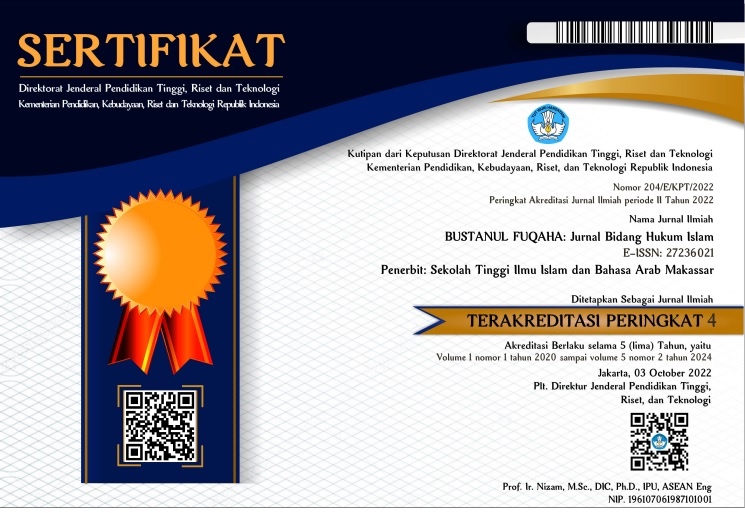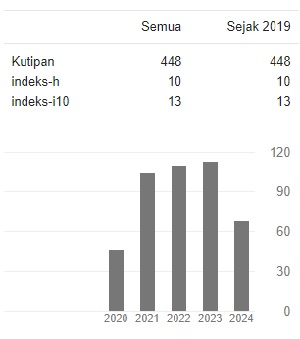Euthanasia dalam Perspektif Kaidah Fikih al-Ḍararu Lā Yuzālu bi al-Ḍarar
DOI:
https://doi.org/10.36701/bustanul.v1i4.271Keywords:
Eutanasia, Fiqh Rules, Code of Ethichs in Medical WorldAbstract
Eutanasia is an attempt, action and assistance carried out by a doctor intentionally accelerating the death of a person, which he estimates is nearing death with the aim of alleviating or freeing his suffering. This study aims to determine and understand the practice of Eutanasia in the perspective of the principle of fiqh al-ḍarar lā yuzālu bi al-ḍarar. The problems that the authors raise in this study are: First, how to apply Eutanasia in the perspective of medical ethics. Second, how is the concept of the principle of fiqh al-ḍararu lā yuzālu bi al-ḍarar. Third, what is the position of Eutanasia in the perspective of the rules of al-larar lā yuzālu bi al-ḍarar. To get answers to these problems, the authors use descriptive qualitative (non-statistical) research that focuses on the study of texts and texts. And using the method of historical, juridical-ormative and philosophical approaches. The research results found are as follows; First, Eutanasia is contrary to the medical code of ethics, although this practice is applied in several countries through procedures and requirements that must be met. The two harms must be removed but cannot be eliminated by the other harm. Third Eutanasia is divided into two, namely active Eutanasia and passive Eutanasia. Active Eutanasia of scholars agree that the law is haram, whereas passive Eutanasia there are differences in ulama in it.
Downloads
References
Al-Qur’an dan Terjemahnya.
Achadiat, Crisdiono M. (2007). Dinamika Etika dan Hukum Kedokteran dalam Tantangan Zaman. t. Cet; Jakarta: EGC.
Al-Bukhārī, Abu Abdillah Muhammad bin Ismail. (1994). Ṣaḥīḥ Bukhārī, Jilid. V. t. Cet; Beirūt Dārul Fikr: Beirūt.
Al-Nadwi, Ali Ahmad al-Qawāid al-Fiqhiyyah. (1986). t. Cet; Damaskus: Dār al-Qalam.
Al-Shiddieqy, Muhammad Hasbi. (1990). Falsafah Hukum Islam. Cet. IV; Jakarta: Bulan Bintang.
Al-Zuhaili, Muhammad Musthafa. (2006). al-Qawāid al-Fiqhiyyah wa Taṭbīqatuha fi al-Mażāhib al-Arba’ah. t.Cet; Damaskus: Dār al-Fikr.
Anantarum, Muhammad Andika Nugraha (2015). Hubungan Pelaksanaan Etika Profesi Dokter dalam Persetujuan Tindakan Medis (Informed Consent) Ditinjau dari Undang-undang Nomor 20 Tahun 2004 Tentang Praktik Kedokteran di RSUD Kudus, Skripsi Fak. Hukum Universitas Negeri Semarang. p. 23.
Aswar, A., Usman, M. H., & Iskandar, A. (2020). Strategi Terapiutik Korban Homoseks: Studi Terhadap Pemikiran Ibnu Qayyim al-Jauziyah. Islamic Counseling: Jurnal Bimbingan dan Konseling Islam, 4(2), 127-154.
Bertens, Kees Keprihatinan Moral, Telaah atas Masalah Etika, https://books.google.co.id/books?id=Yfz6fCEjv6IC&printsec=frontcover&dq=k+bertens+Eutanasia&hl=en&sa=X&ei=Flr7UI7YKsPYrQfz8IGgBw&sqi=2&redir_esc=y#v=onepage&q&f=false.GoogleBooks, Internet. 22 Desember 2012.
Djazuli. (2010). Kaidah-kaidah Fikih: Kaidah-kaidah Hukum Islam dalam Menyelesaikan masalah-masalah yang Praktis. Cet. III; Jakarta: Kencana.
Hanafiah, M. Jusuf dan Amri Amir, (1999). Etika Kedokteran dan Hukum Kesehatan. t. Cet; Jakarta: EGC.
Hasan, M. Ali. (1995). Masāil Fiqhiyah al-Ḥadīṡah pada Masalah-masalah Kontemporer Hukum Islam. t. Cet; Jakarta: Raja Grafindo Persada.
Idris, M. N., & Anita, K. (2020). Analisis Implementasi Kaidah Fikih Lā Ḍarar Wa Lā Ḍirār dalam Kedokteran Modern pada Kasus Tindakan Operasi. NUKHBATUL'ULUM: Jurnal Bidang Kajian Islam, 6(1), 50-76.
Indriani, D., Sam, Z., & Yudianti, S. (2020). Tinjauan Hukum Islam terhadap Peraturan Pemerintah tentang Kebolehan Aborsi pada Kasus Kedaruratan Medis dan Perkosaan. BUSTANUL FUQAHA: Jurnal Bidang Hukum Islam, 1(3), 440-457.
Mukti, Ali Ghufran dan Adi Heru Sutomo. (1997). Abortus, Bayi Tabung, Eutanasia, Transplantasi Ginjal dan Opersai Kelamin dalam Tinjauan Medis. Cet. I; Yogyakarta: Yayasan Panca Dharma.
Musbikin, Imam. (2001). Qawā’id al-Fiqhiyyah. Cet. I; Jakarta: PT Raja Grafindo Persada.
Nugraha, Septian. (2015). Eutanasia Dihubungkan dengan Hukum Pidana dan Undang-undang Nomor 39 Tahun 1999 Tentang Hak Asasi Manusia, Skripsi Fak. Hukum Universitas Hasanuddin. p. 50.
Qardhawi, Yusuf. (1995). Hadyul Islām Fatāwā Mu’āṣirah, terj. As’ad Yasin, Fatwa-fatwa Kontemporer. Jakarta: Gema Insani Press.
Rianawati, Ani. (2011). Eutanasia dalam Perspektif Hukum Pidana dan Hukum Islam, Skripsi Fak. Syariah STAIN. p.75.
Samil, Ratna Suprapti. (2001). Etika Kedokteran Indonesia. Cet. I; Jakarta: Yayasan Bina Pustaka Sarwono Prawirohardjo.
Taimiyah, Ibnu. Al-Fatāwa al-Kubrā. (t.th). t. Cet; Juz IV: Kairo:Mathba’ah Kurdistan.
Tribowo, Cecep. (2014). Etika dan Hukum Kesehatan . t. Cet; Yogyakarta: Nuha Medika.














